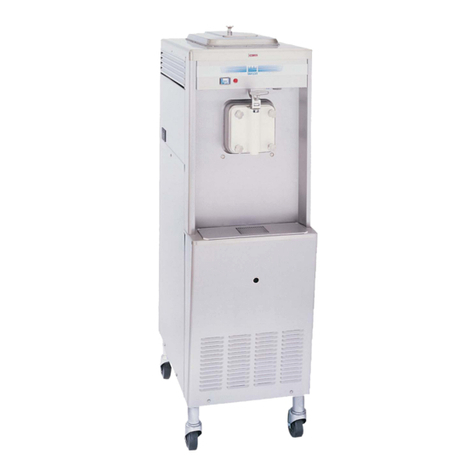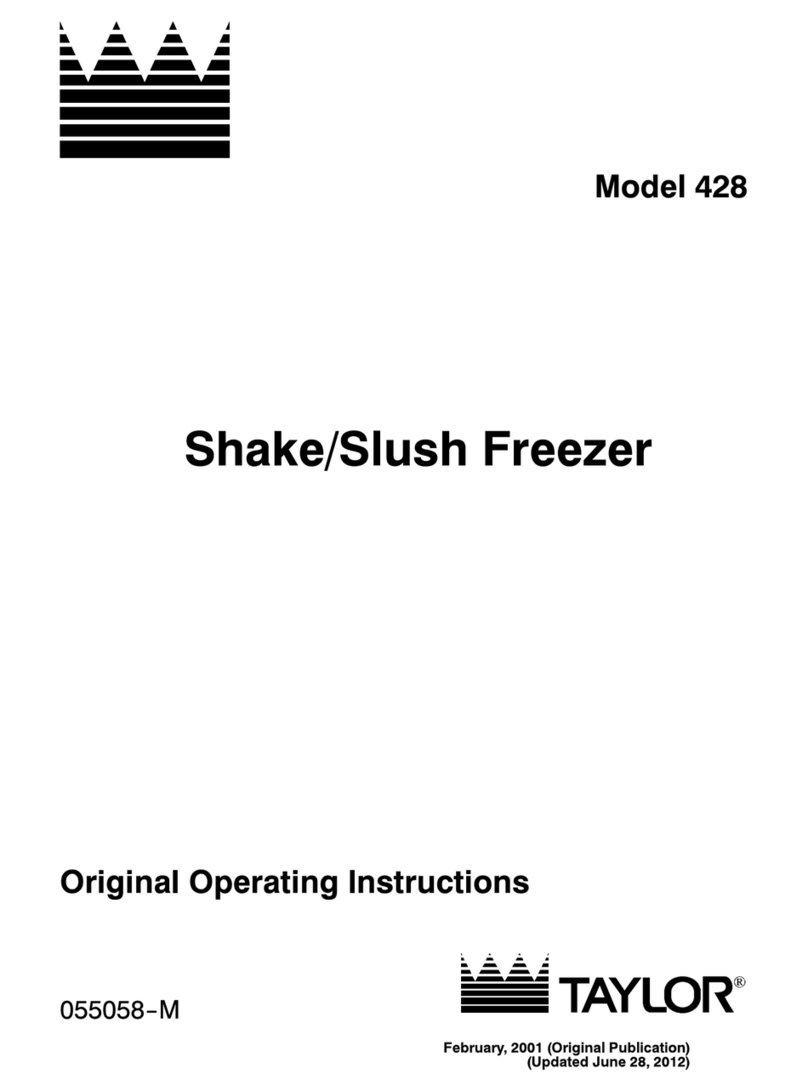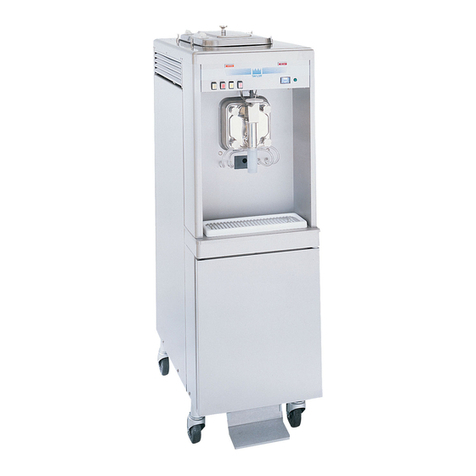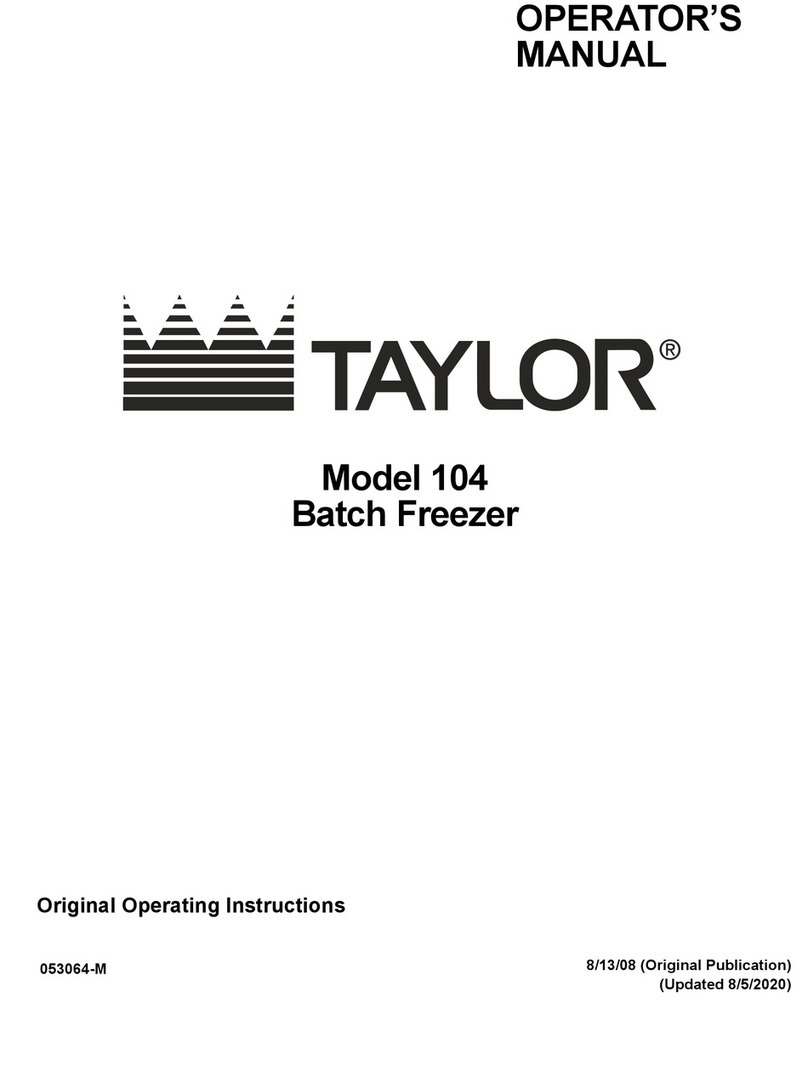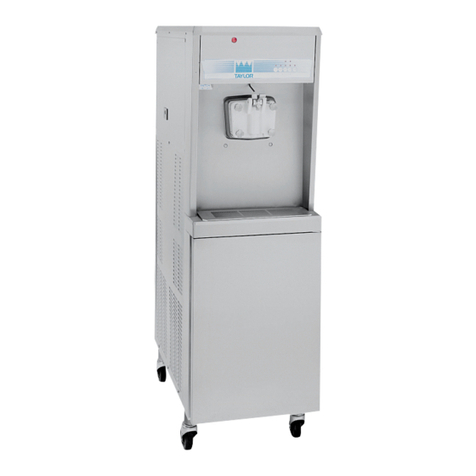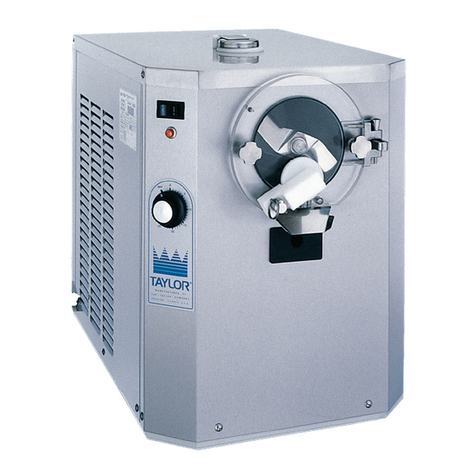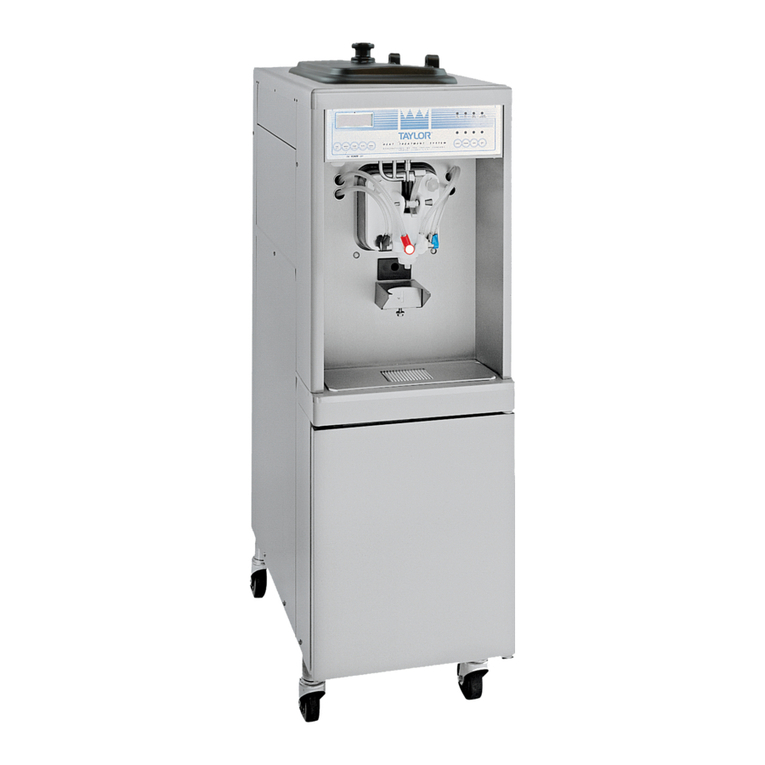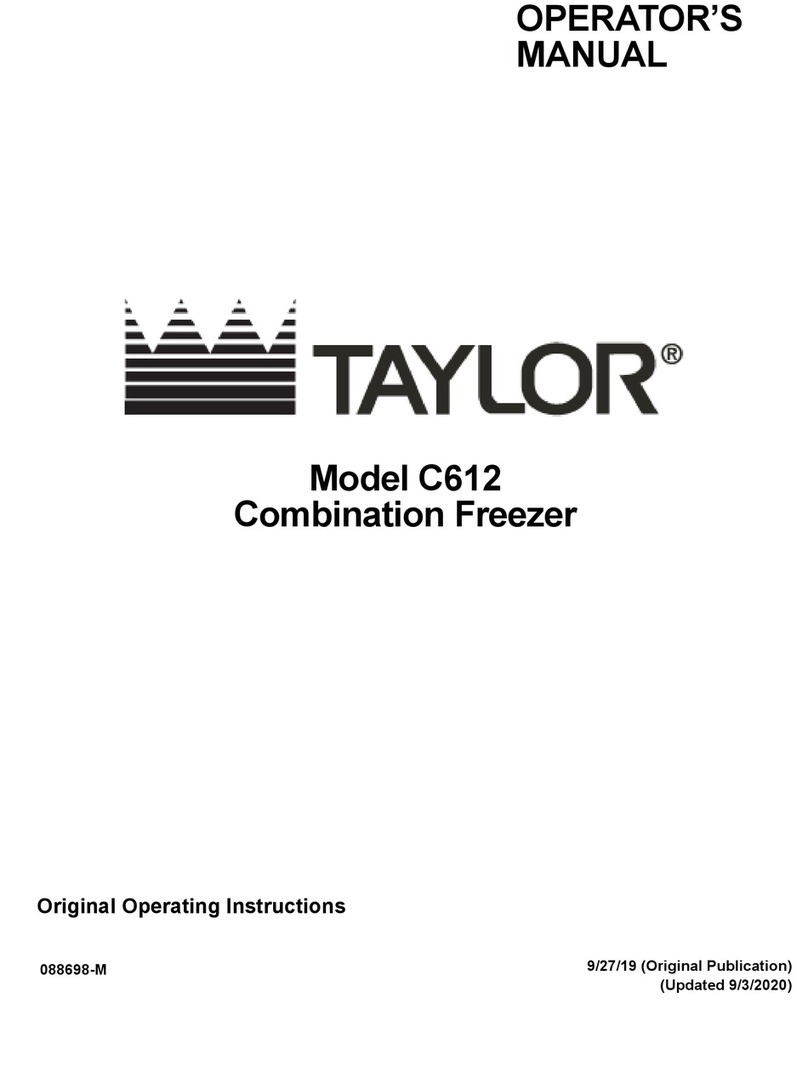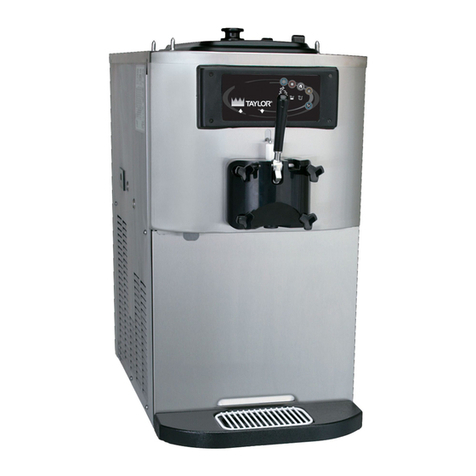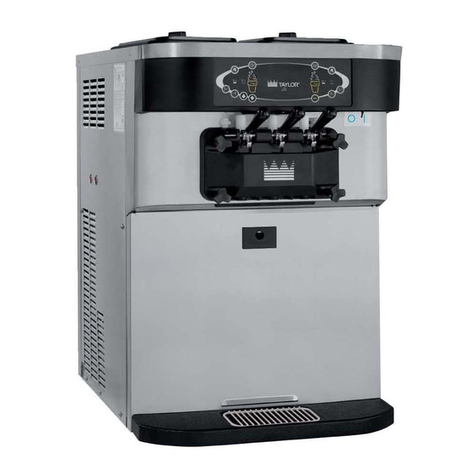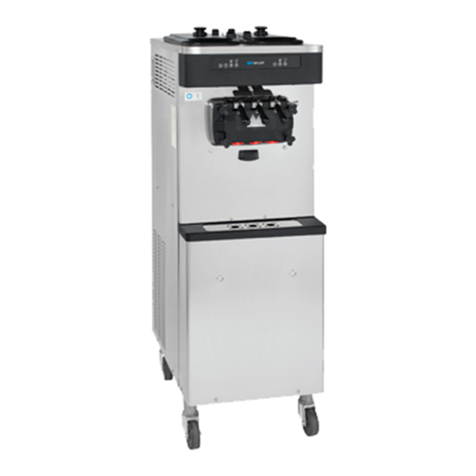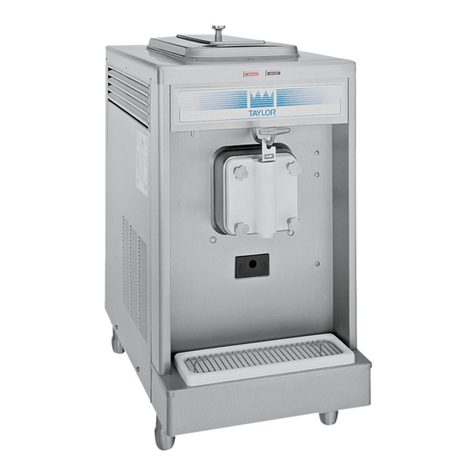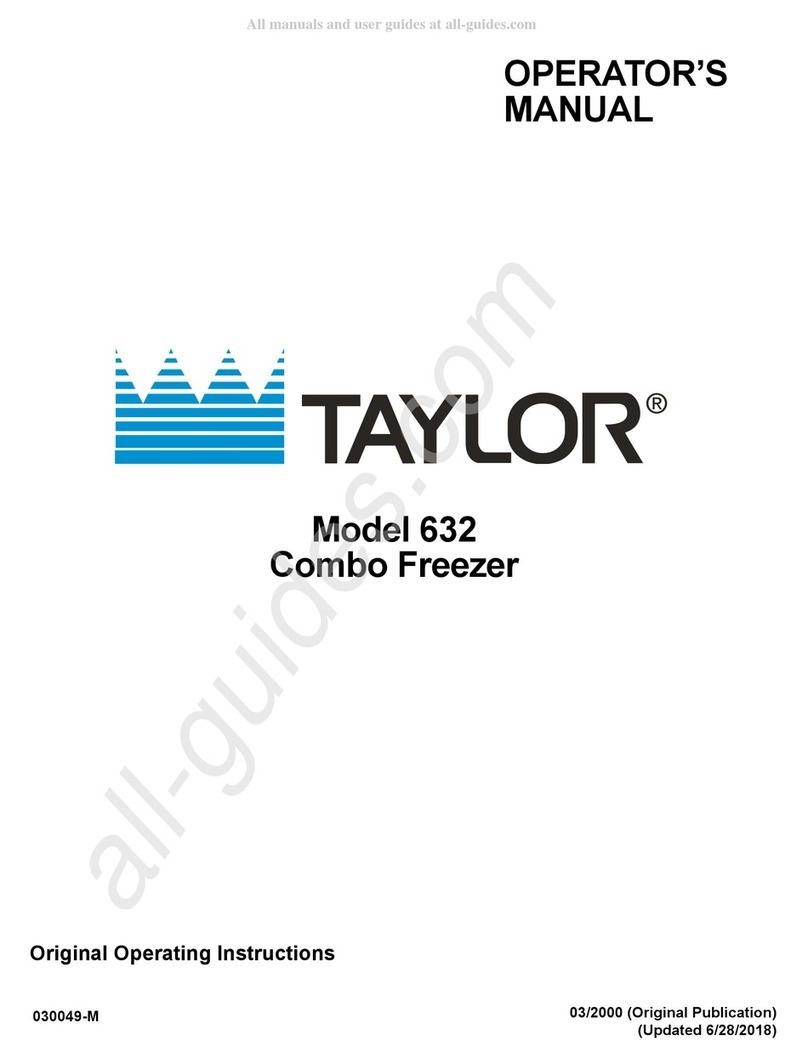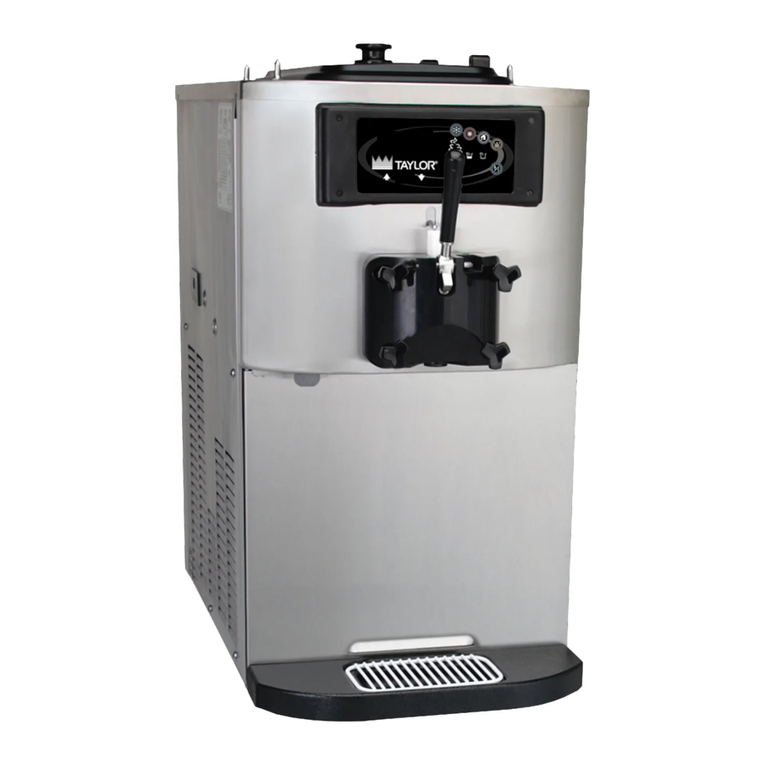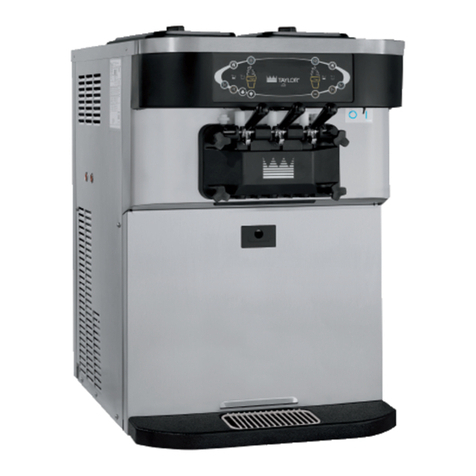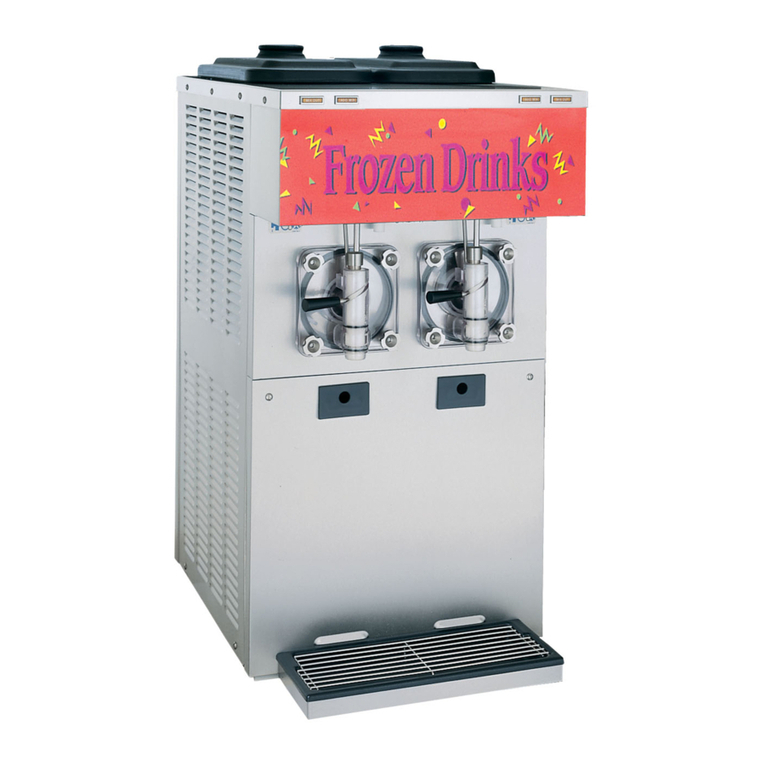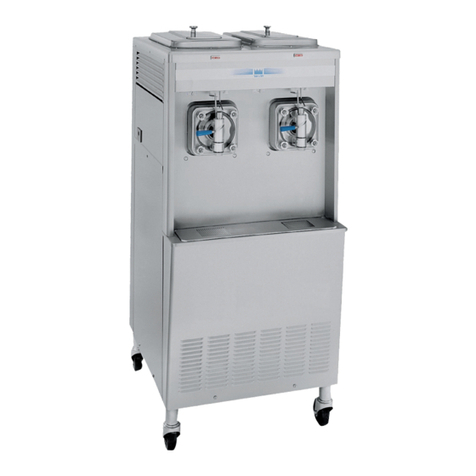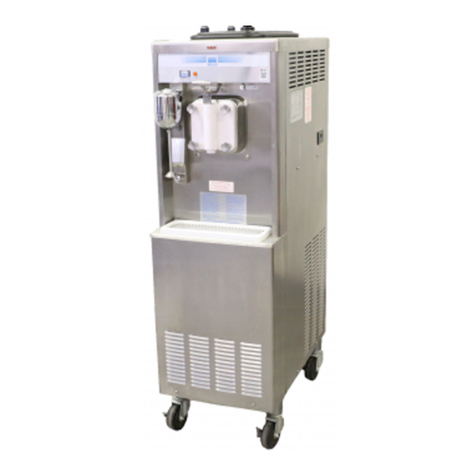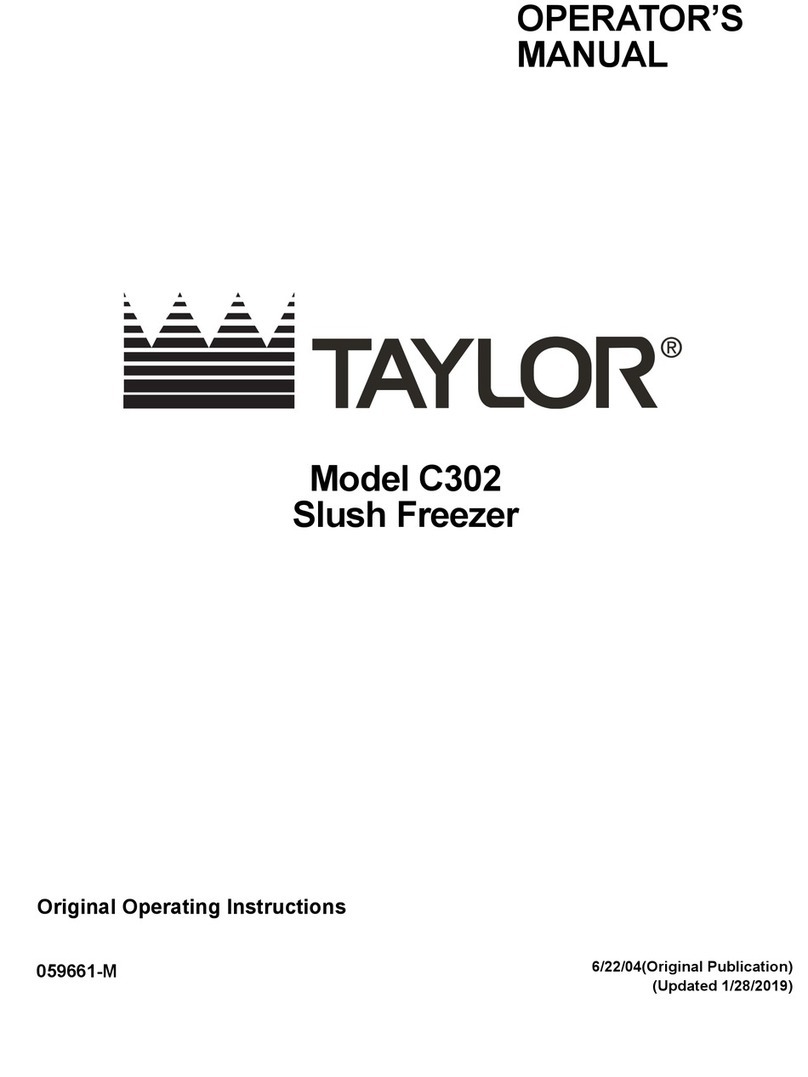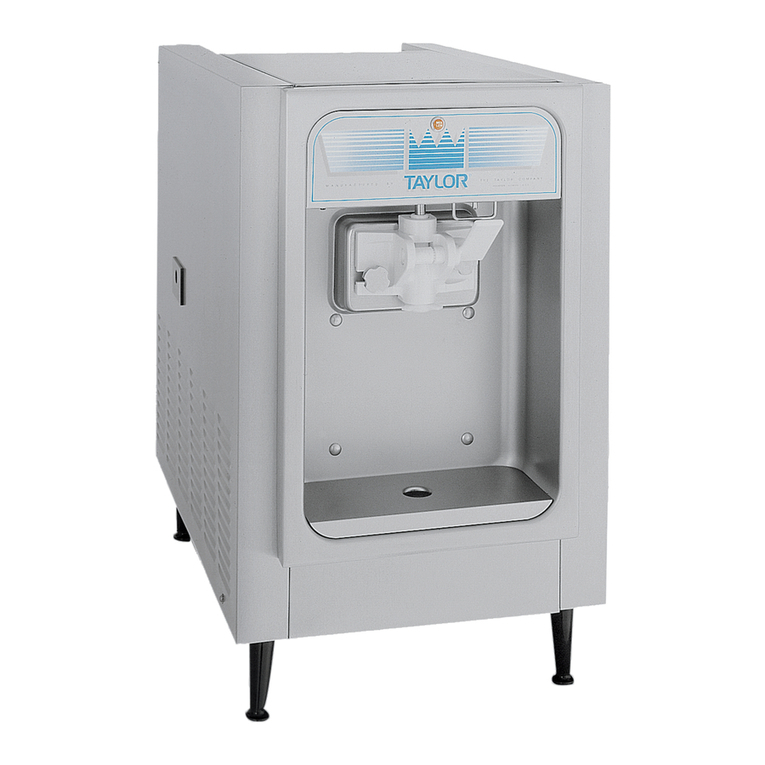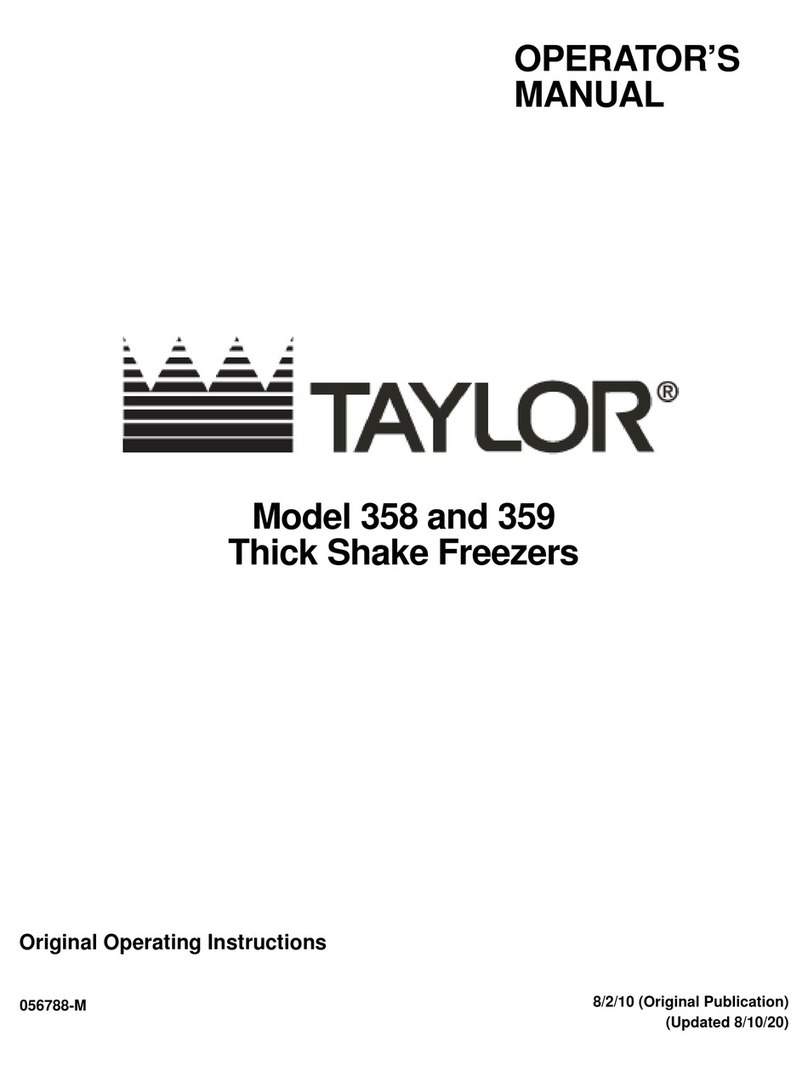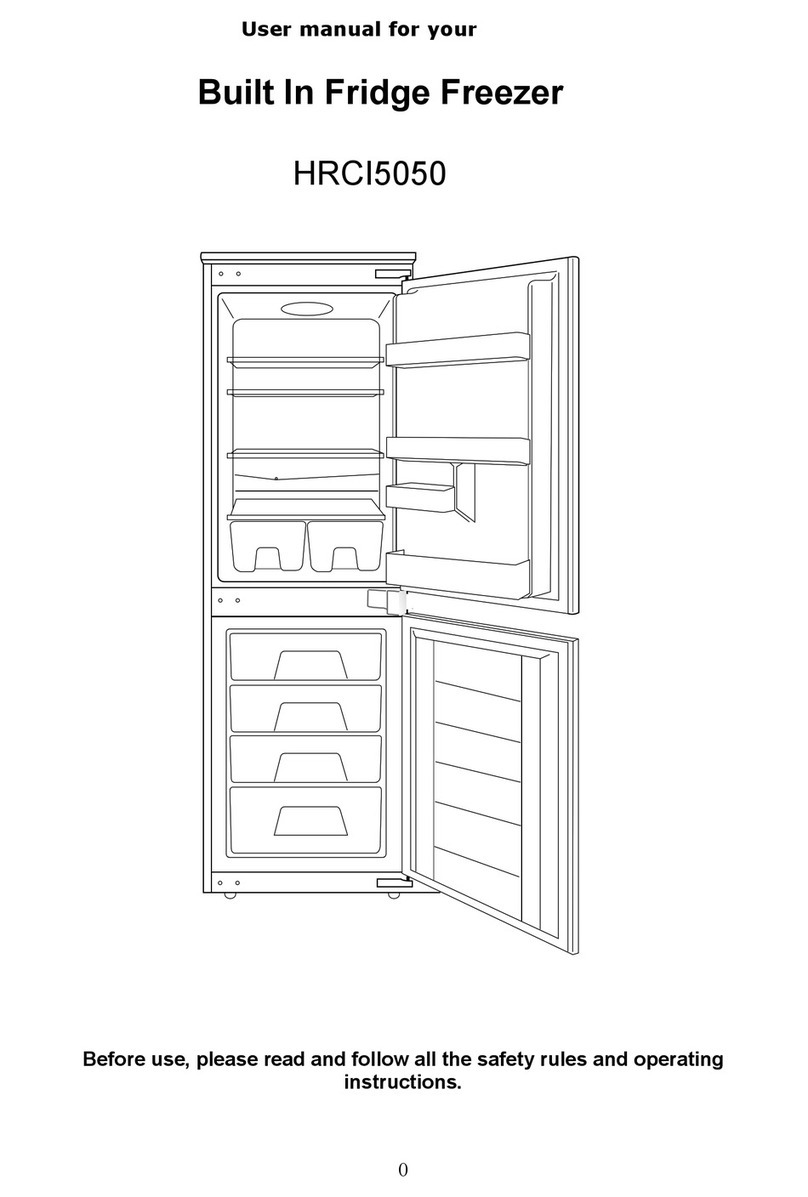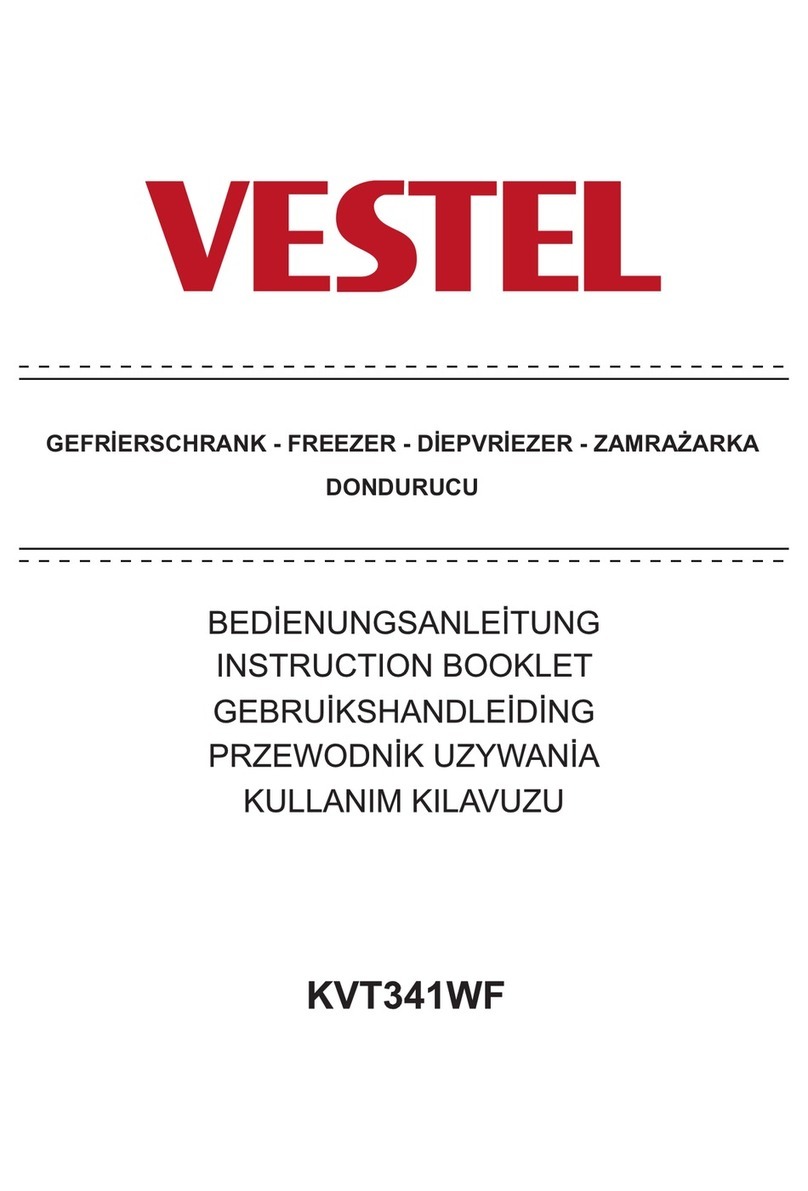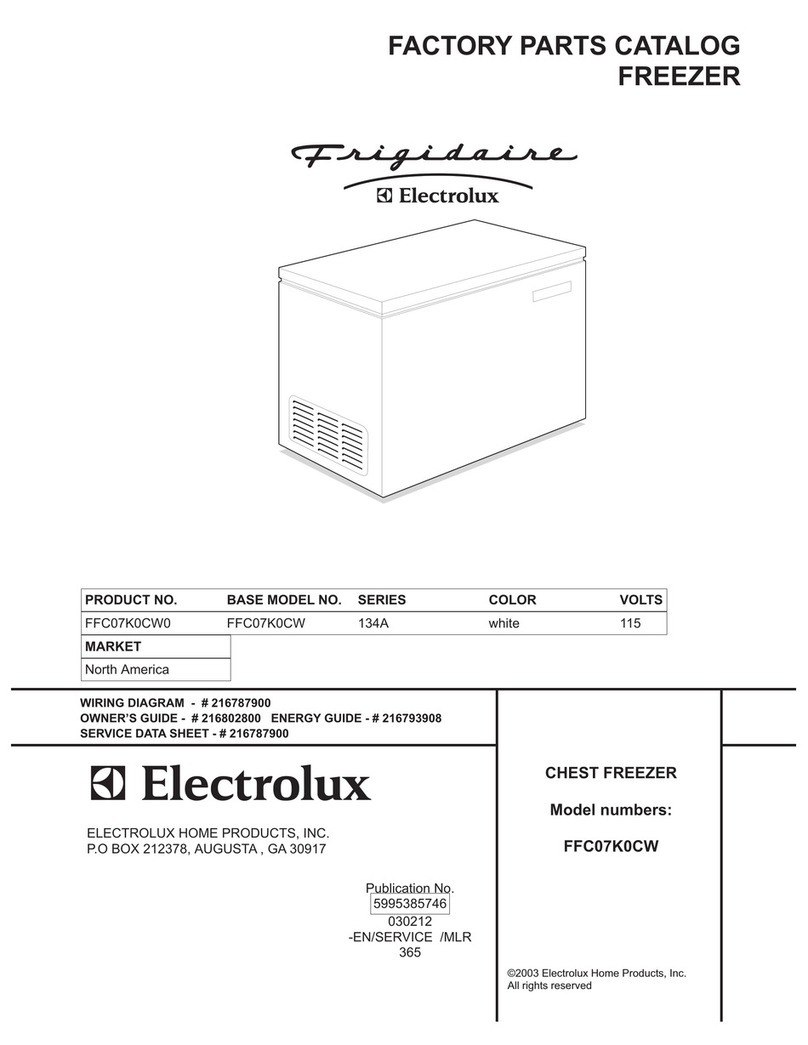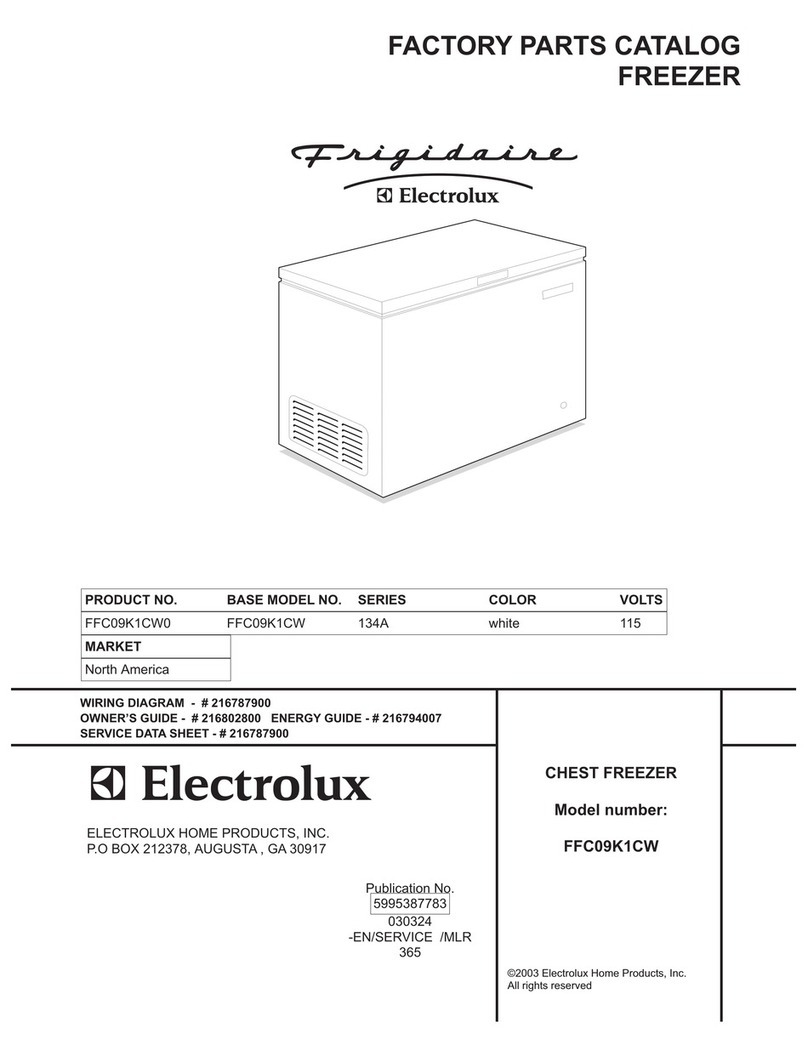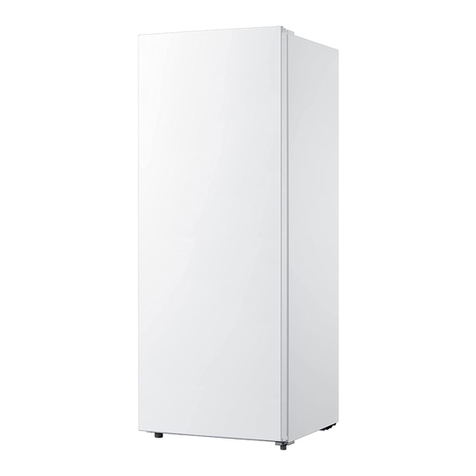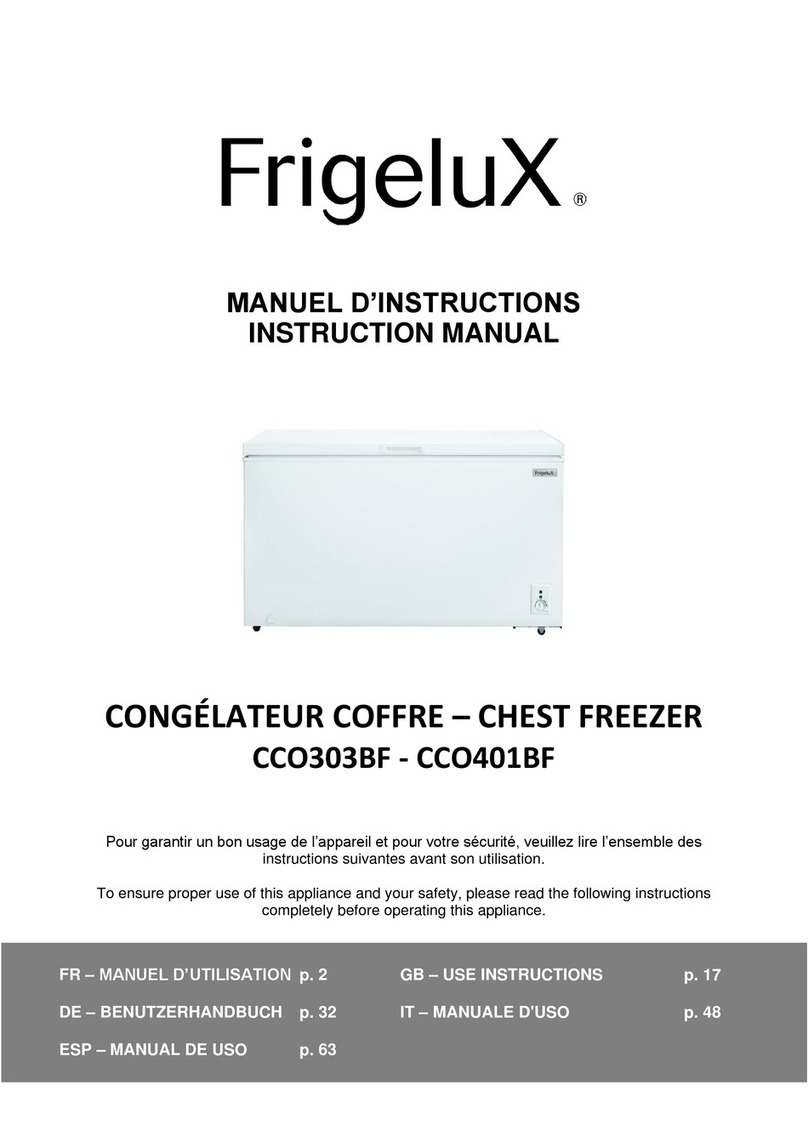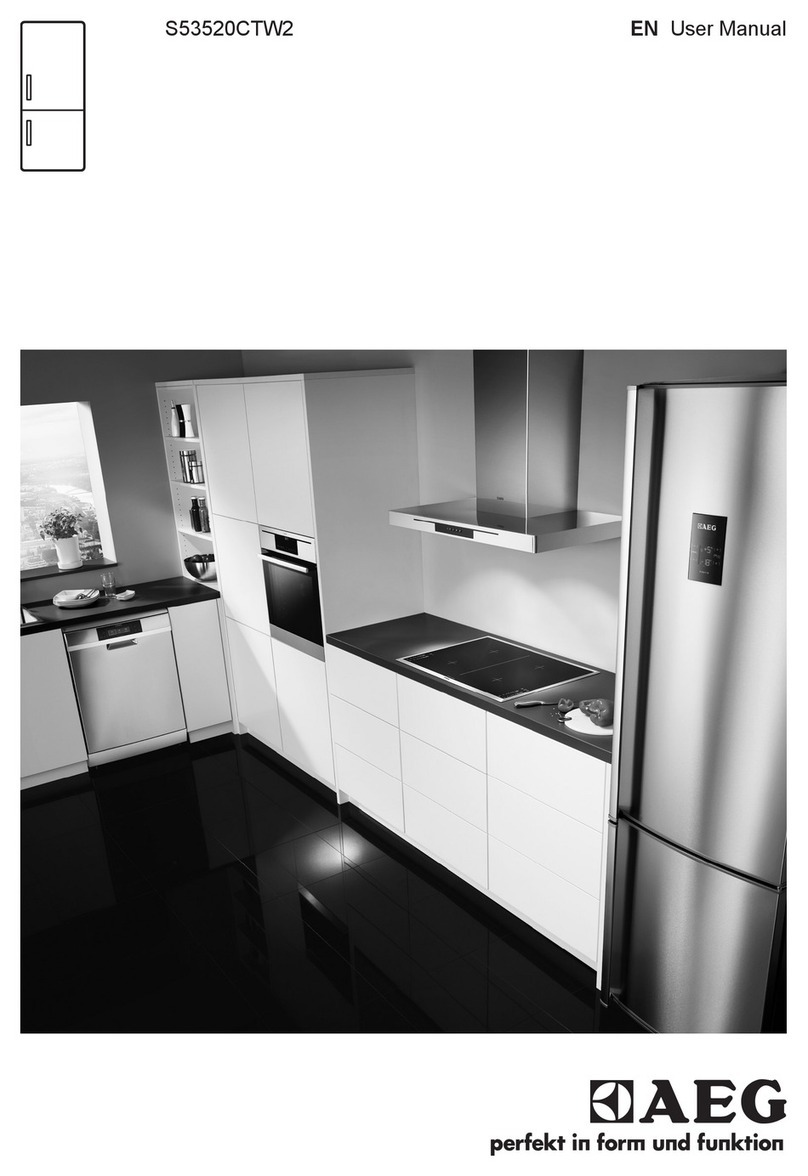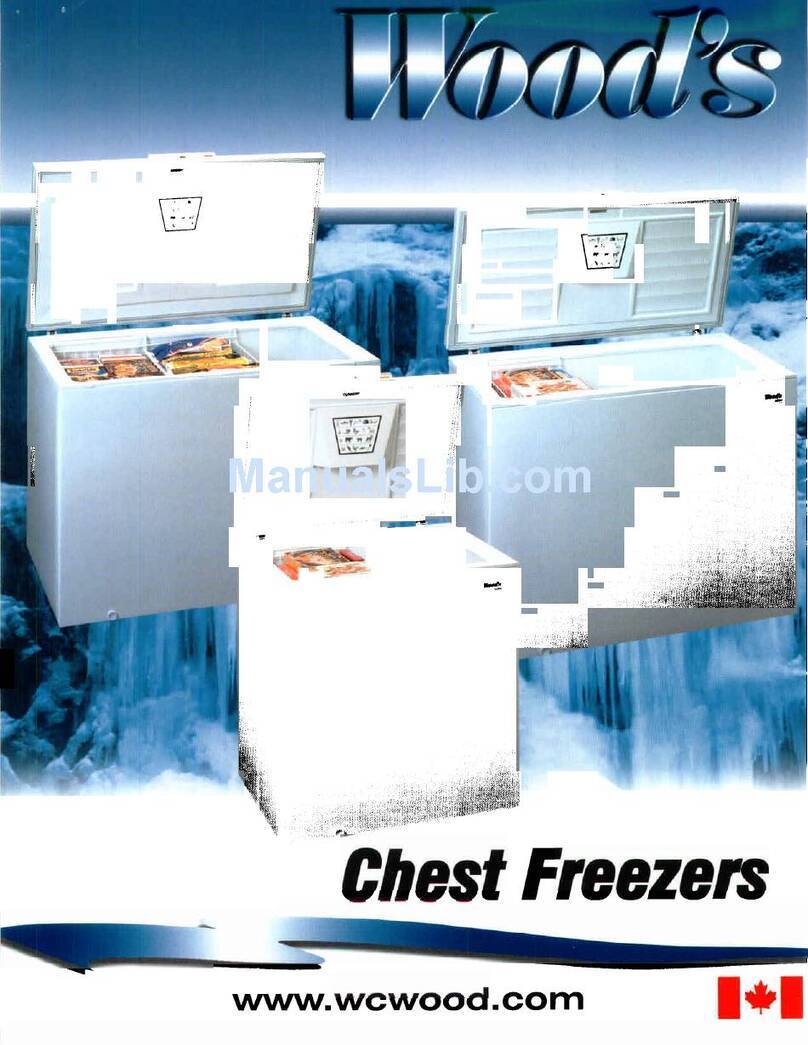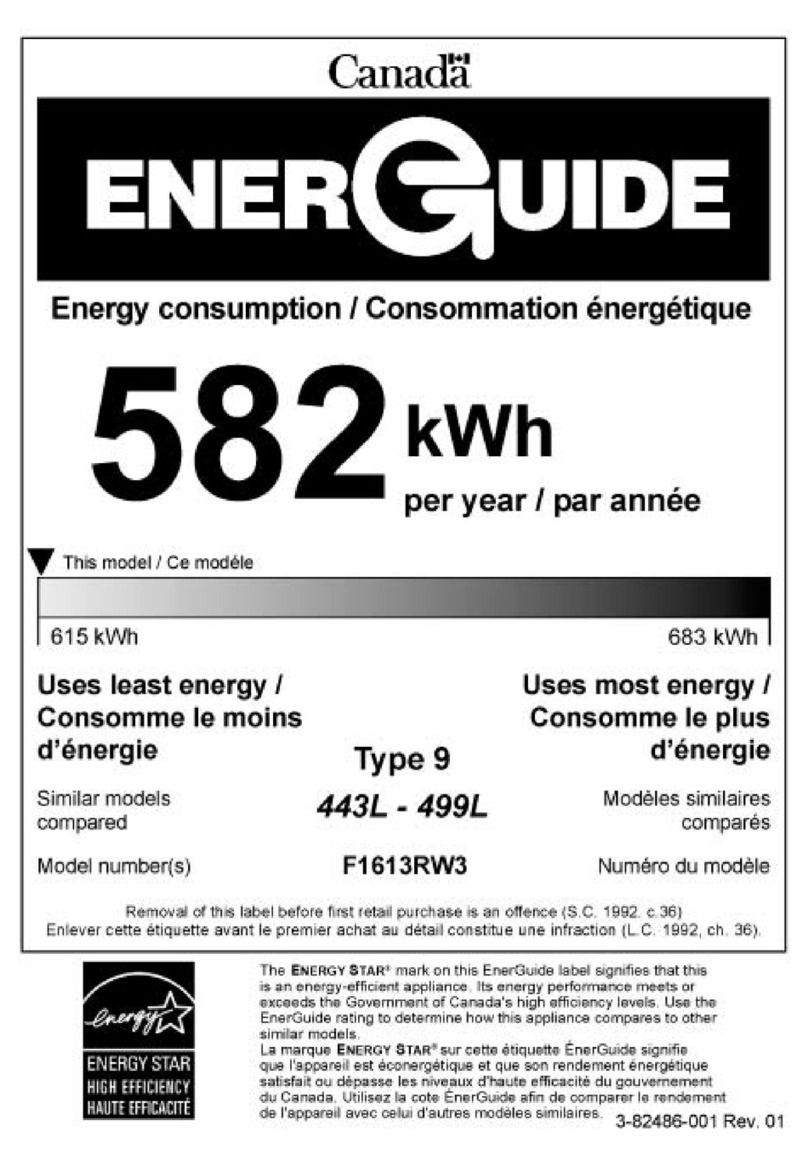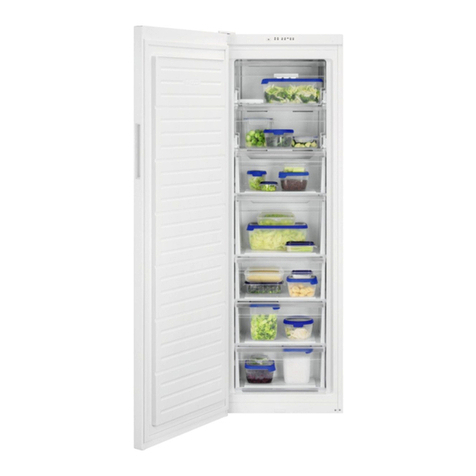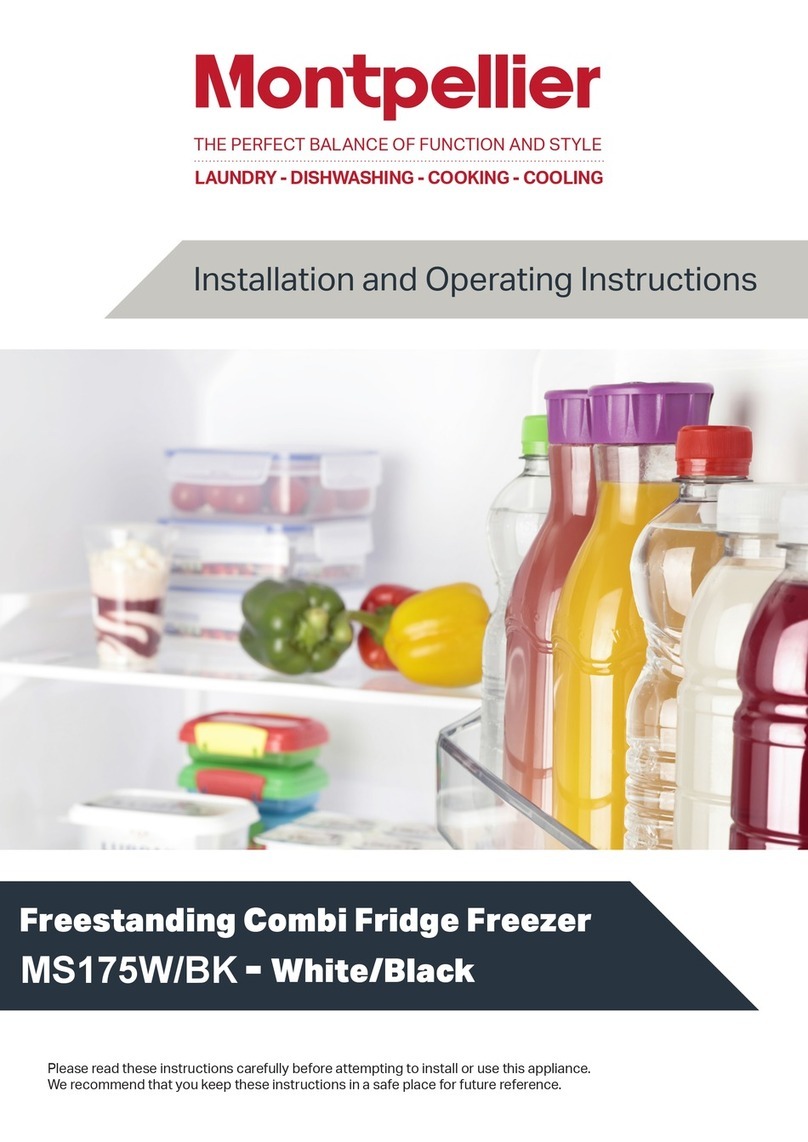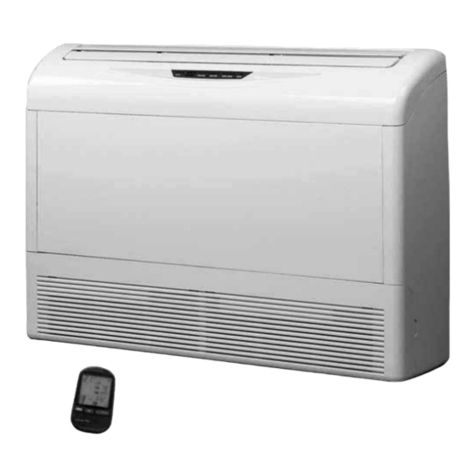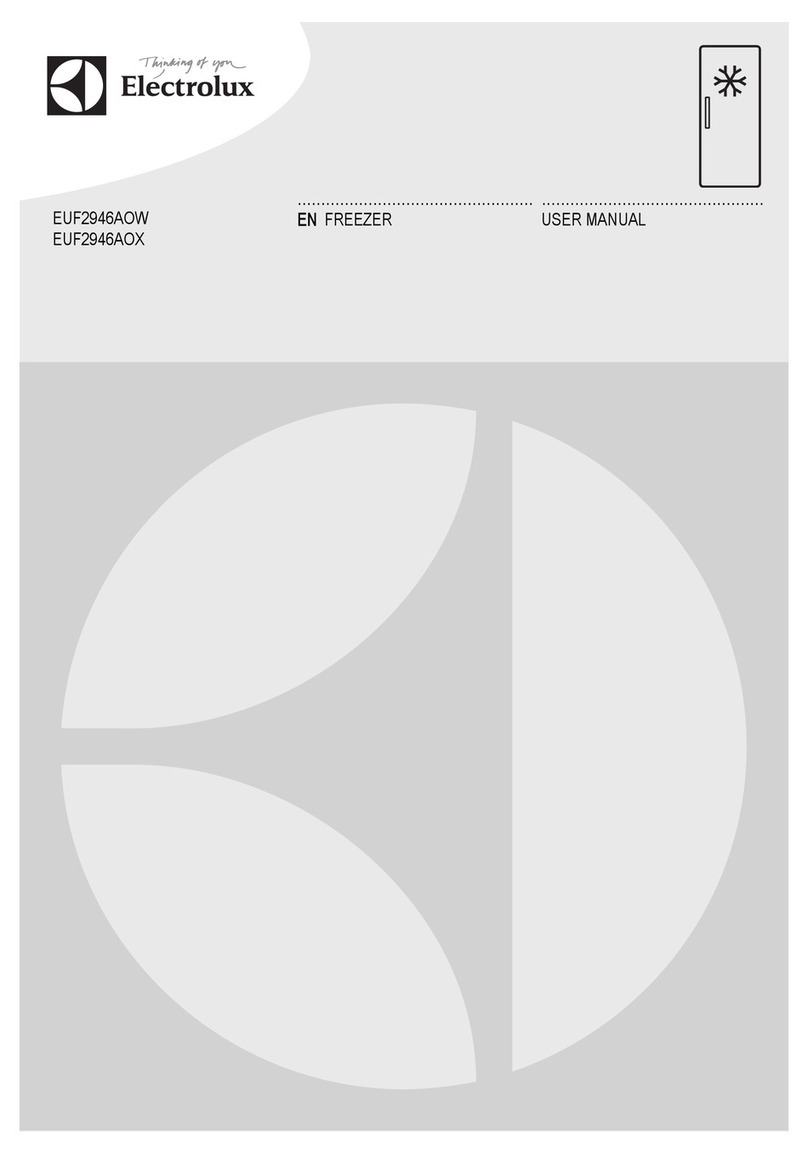Taylor Taylormate 150 User manual

SERVICE
MANUAL
Model 150, 152, 162 & 168
Soft Serve Freezers
Service Manual
028749−S 5/99 (Original Publication)
(Updated 2/11/16


Table of Contents Models 150, 152, 162, 168
Table of Contents
Section 1: Introduction 1...............................................
Safety 2.............................................................
Model 150 Specifications 4.............................................
Model 152 Specifications 5.............................................
Model 162 Specifications 6.............................................
Model 168 Specifications 7.............................................
Running Specifications 8...............................................
General Installation Instructions 9.......................................
Environmental Notices 12...............................................
Section 2: Controls and Systems 13......................................
Refrigeration Schematic 14..............................................
Separate Hopper Refrigeration (SHR) 15.................................
Temperature Control 16.................................................
Viscosity Control 18....................................................
TQC Control 21........................................................
Section 3: Troubleshooting Guide 23.....................................
General Troubleshooting 24.............................................
Control Troubleshooting 27..............................................
Watt Control Troubleshooting 28.........................................
Section 4: Parts 29......................................................
Warranty Explanation 30................................................
Model 150 Exploded View 32............................................
Model 150 Operator Parts Identification 34................................
Model 152 Operator Parts Identification 35................................
Model 152 Exploded View 36............................................
Model 162 Exploded View 38............................................
Model 162 Operator Parts Identification 40................................
Model 168 Operator Parts Identification 41................................

Models 150, 152, 162, 168 Table of Contents
Table of Contents - Page 2
Model 168 Exploded View 42............................................
Beater & Door A. (Models 150/152) 44....................................
Beater & Door A. (Models 162/168) 45....................................
Control A.−Upper −X51544−27 (Models 150 & 152) 46.....................
Control A. −X51543−27 (Model 152) 47..................................
Control A. −X50146−27 (Model 162 Left) 48..............................
Control A. −X50147−27 (Model 162 Right) 49.............................
Control A. −X51730−27 (Models 162 & 168 Front) 50......................
Control A. −X50342−27L (Model 168 Left) 51.............................
Control A. −X50342−27R (Model 168 Right) 52............................
Box A.−Cap & Relay −X50198−27 (Model 150) 53.........................
Relay A.−Timer Stir −X51685−27 (Model 150) 54..........................
Relay A.−Timer Stir −X51633−27 (Model 162) 55..........................
Relay A.−Timer Stir −X51323−27 (Model 168) 56..........................
Parts List 57...........................................................
Wiring Diagrams 68....................................................
Note: Continuing research results in steady improvements; therefore, information in this
manual is subject to change without notice.
CAUTION: Information in this manual is intended to be used by Taylor Authorized Service
Technicians only.
Note: Only instructions originating from the factory or its authorized translation
representative(s) are considered to be the original set of instructions.
E1999 Carrier Commercial Refrigeration, Inc. (Original Publication)
(Updated February, 2016)
028749−S
Any unauthorized reproduction, disclosure, or distribution of copies by any person of any portion of this work may be
a violation of Copyright Law of the United States of America and other countries, could result in the awarding of Statutory
Damages of up to $250,000 (17 USC 504) for infringement, and may result in further civil and criminal penalties.
All rights reserved.
Taylor Company
a division of Carrier Commercial Refrigeration, Inc.
750 N. Blackhawk Blvd.
Rockton, IL 61072

1
Models 150, 152, 162, 168 Introduction
Section 1: Introduction
SSafety
SSpecifications
SRunning Specifications
SGeneral Installation Instructions
SEnvironmental Notices

2
Introduction Models 150, 152, 162, 168
110801
Safety
_________________________________
We, at Taylor Company, are committed to
manufacturing safe operating and serviceable
equipment. The many built−in safety features that are
part of all Taylor equipment are aimed at protecting
operators and trained service technicians alike.
This manual is intended exclusively for
Taylor authorized service personnel.
DO NOT attempt to run the equipment unless
you have been properly trained to do so.
CAUTION: THIS EQUIPMENT MUST BE
PROPERLY GROUNDED! Do not operate this freezer
unless it is properly grounded and all service panels
and access doors are restrained with screws. Failure
to do so can result in severe personal injury from
electrical shock!
SDO NOT attempt any repairs unless the
main power supply to the freezer has been
disconnected.
SDO NOT operate the freezer with larger
fuses than specified on the data label.
SStationary appliances which are not
equipped with a power cord and a plug or
other device to disconnect the appliance
from the power source must have an
all−pole disconnecting device with a contact
gap of at least 3 mm installed in the external
installation.
SAppliances that are permanently connected
to fixed wiring and for which leakage
currents may exceed 10 mA, particularly
when disconnected, not used for long
periods, or during initial installation, shall
have protective devices such as a GFI to
protect against the leakage of current and
be installed by authorized personnel to the
local codes.
SSupply cords used with this unit shall be
oil−resistant, sheathed flexible cable, not
lighter than ordinary polychloroprene or
other equivalent synthetic
elastomer−sheathed cord (Code designation
60245 IEC 57) installed with the proper cord
anchorage to relieve conductors from strain,
including twisting, at the terminals and
protect the insulation of the conductors from
abrasion.
Failure to follow these instructions may result in
electrocution or damage to the machine.
This unit is provided with an equipotential
grounding lug that is to be properly attached to either
the rear of the frame or the under side of the base pan
near the entry hole for incoming power, by the
authorized installer. The installation location is marked
by the equipotential bonding symbol (5021 of IEC
60417-1) on both the removable panel and the
equipment’s frame, as well as on the diagram.
DO NOT remove the freezer door or any
internal operating parts (examples: beater, scraper
blades, etc.) unless all control switches are in the OFF
position. Failure to follow these instructions may result
in severe personal injury from hazardous moving
parts.
THIS UNIT HAS MANY SHARP EDGES
THAT CAN CAUSE SEVERE INJURIES.
Examples:
Sscraper blades
Scondenser fins

3
Models 150, 152, 162, 168 Introduction
110801
This unit must be installed on a level surface
to avoid the hazard of tipping. Extreme care should be
taken in moving this equipment for any reason.
Two or more people are required to safely move this
unit. Failure to comply may result in personal injury or
equipment damage.
This unit must NOT be installed in an area
where a water jet or hose can be used. NEVER use a
water jet or hose to rinse or clean this unit. Using a
water jet or hose on or around this equipment may
result in electrocution to the user or damage to the
equipment.
Cleaning and sanitizing schedules are
governed by your state or local regulatory agencies
and must be followed accordingly. Please refer to the
cleaning section of the Operator Manual for the proper
procedure to clean this unit.

4
Introduction Models 150, 152, 162, 168
160212
Model 150 Specifications
Freezing Cylinder
One, 1.5 quart (1.4 liter).
Mix Hopper
One, 8 quart (7.6 liter).
Beater Motor
One, 0.5 hp.
Refrigeration Unit
One, approximately 3,000 btu/hr. compressor.
Refrigerant: R404A.
One, independent SHR compressor, approximately
400 btu/hr. R134a. (BTU’s may vary based on
compressor used.)
Electrical
Electrical Total
Amps Supplied With
115/60/1 Air 16.0 20 amp. cord and plug
208-230/60/1 Air 10.2 15 amp. cord and plug
This unit may be manufactured in other electrical
characteristics. Refer to the local Taylor Distributor for
availability. (For exact electrical information, always
refer to the data label of the unit.)
Air Cooled
Clearance: 6” (152 mm) around both sides. Install the
skirt provided on the right side of the unit and place the
back of the unit against a wall to prevent recirculation
of warm air.
Dimensions
Width: 14-1/16” (357 mm)
Depth: 24” (610 mm)
Height: 51-1/2” (1308 mm)
Floor Clearance: 3-11/16” (94 mm) mounted on
standard casters.
Approximate Weights
Net: 250 lbs. (113.4 kgs.)
Crated: 292 lbs. (132.4 kgs.)
Volume: 21.1 cu. ft. (.60 cu. m.)
Figure 1

5
Models 150, 152, 162, 168 Introduction
140508
Model 152 Specifications
Freezing Cylinder
One, 1.5 quart (1.4 liter).
Mix Hopper
One, 8 quart (7.6 liter).
Beater Motor
One, 0.5 hp.
Refrigeration Unit
One, approximately 3,000 btu/hr. compressor.
Refrigerant: R404A.
One, independent SHR compressor, approximately
400 btu/hr. R134a. (BTU’s may vary based on
compressor used.)
Electrical
Electrical Total
Amps
Supplied With
NEMA Cord
115/60/1 Air 16.0 5−20P
208-230/60/1 Air 10.2 6−15P
220−240/50/1 Air 7.8 −−−
This unit may be manufactured in other electrical
characteristics. Refer to the local Taylor Distributor for
availability. (For exact electrical information, always
refer to the data label of the unit.)
Air Cooled
Clearance: 6” (152 mm) on both sides. Install the skirt
provided on the right side of the unit and place the back
of the unit against a wall to prevent recirculation of
warm air.
Dimensions
Width: 17−7/16” (441.9 mm)
Depth: 27-11/16” (702.0 mm)
Height: 30” (711.2 mm)
Counter Clearance: 3−15/16” (101.0 mm)
(Mounted on standard legs.)
Approximate Weights
Net: 212 lbs. (96.2 kgs.)
Crated: 243 lbs. (110.2 kgs.)
Volume: 21.1 cu. ft. (.60 cu. m.)
Figure 2

6
Introduction Models 150, 152, 162, 168
060316
Model 162 Specifications
Freezing Cylinder
Two, 1.5 quart (1.4 liter).
Mix Hopper
Two, 8 quart (7.6 liter).
Beater Motor
Two, 0.5 hp.
Refrigeration Unit
Two, approximately 3,000 btu/hr. compressors.
Refrigerant: R404A.
One, independent SHR compressor, approximately
400 btu/hr. R134a. (BTU’s may vary based on
compressor used.)
Electrical
Electrical
Two dedicated connections.
Maximum
Fuse Size
Minimum
Circuit Ampacity
115/60/1 Air Left Right Left Right
25 20 20 16
Electrical
One dedicated connection.
Maximum
Fuse Size
Minimum
Circuit Ampacity
208-230/60/1 Air 20 19
This unit may be manufactured in other electrical
characteristics. Refer to the local Taylor Distributor for
availability. (For exact electrical information, always
refer to the data label of the unit.)
Air Cooled
Clearance: 3” (76 mm) on all sides. Install the skirt
provided on the rear of the unit to prevent recirculation
of warm air.
Dimensions
Width: 29” (737 mm)
Depth: 24” (610 mm)
Height: 31” (787 mm)
Counter Clearance: 4-1/4” (108 mm) mounted on
standard legs.
Approximate Weights
Net: 410 lbs. (186.0 kgs.)
Crated: 460 lbs. (209.0 kgs.)
23.2 cu. ft. (.65 cu. m.)
Figure 3

7
Models 150, 152, 162, 168 Introduction
060316
Model 168 Specifications
Freezing Cylinder
Two, 1.5 quart (1.4 liter).
Mix Hopper
Two, 8 quart (7.6 liter).
Beater Motor
Two, 0.5 hp.
Refrigeration Unit
Two, approximately 3,000 btu/hr. compressors.
Refrigerant: R404A.
One, independent SHR compressor, approximately
400 btu/hr. R134a. (BTU’s may vary based on
compressor used.)
Electrical
Electrical
Two dedicated connections.
Maximum
Fuse Size
Minimum
Circuit Ampacity
115/60/1 Air Left Right Left Right
25 20 20 16
Electrical
One dedicated connection.
Maximum
Fuse Size
Minimum
Circuit Ampacity
208-230/60/1 Air 20 19
This unit may be manufactured in other electrical
characteristics. Refer to the local Taylor Distributor for
availability. (For exact electrical information, always
refer to the data label of the unit.)
Air Cooled
Clearance: 3” (76 mm) on all sides. Install the skirt
provided on the rear of the unit to prevent recirculation
of warm air.
Dimensions
Width: 20-7/16” (519 mm)
Depth: 24” (610 mm)
Height: 53-3/4” (1365 mm)
Floor Clearance: 3-11/16” (94 mm) mounted on
standard casters.
Approximate Weights
Net: 425 lbs. (192.8 kgs.)
Crated: 482 lbs. (218.6 kgs.)
31.4 cu. ft. (.88 cu. m.)
Figure 4

8
Introduction Models 150, 152, 162, 168
070103
Running Specifications
The following are the pressure and temperature
settings recommended by Taylor, and apply to all
models covered in this manual.
Expansion Valve
Pressure setting: 502 = 18 to 20 PSI
(124 to 138 kPa).
HP62 & HP 81 = 20 to 22 PSI
(138 to152 kPa)
Normal product temperature should range between
18_F to 20_F (-7.8_C to -6.7_C).
Mix hopper and standby temperature should range
between 38_F to 40_F (3.3_C to 4.4_C).
High Side
Head pressure on air cooled units varies depending on
ambient temperatures.
Air Cooled: The following chart indicates normal
operating head pressures at various ambient
temperatures.
Ambient
Temperature
Normal Operating
Head Pressures
F. C. PSI
70_21.1_240 - 270 (1,655 - 1,862 kPa)
80_26.7_270 - 300 (1,862 - 2,069 kPa)
90_32.2_300 - 340 (2,069 - 2,344 kPa)
100_37.8_340 - 380 (2,344 - 2,620 kPa)
Note: This chart applies to units using R502 or 404A
refrigerant.
Low Side
Low side pressure is determined by the expansion
valve setting. Adjust the pressure higher or lower by
turning the adjustment knob on the expansion valve.
Clockwise adjustments will raise the pressure, and
counterclockwise adjustments will lower the pressure.
Note: Make expansion valve adjustments with mix in
the freezing cylinder and with the machine in the
“AUTO” mode. Allow adequate time for pressure to
stabilize.

9
Models 150, 152, 162, 168 Introduction
General Installation Instructions
The following are general installation instructions. For
complete installation details, please see the checkout
card.
Site Preparation
Review the area the unit is to be installed in before
uncrating the unit. Make sure that all possible hazards
the user or equipment may come into have been
addressed.
Clearance: Air Cooled Units
Please see the “Model Specifications” pages for the
minimum clearance requirements of the freezers.
DO NOT obstruct air intake and discharge openings.
If provided, install the deflector to prevent recirculation
of warm air.
Failure to allow proper clearance and airflow may
cause poor freezer performance and damage to the
machine.
For Indoor Use Only: This unit is designed to operate
indoors, under normal ambient temperatures of 70_-
75_F (21_- 24_C). The freezer has successfully
performed in high ambient temperatures of 104_F
(40_C) at reduced capacities.
This unit must NOT be installed in an area
where a water jet or hose can be used. NEVER use a
water jet or hose to rinse or clean this unit. Using a
water jet or hose on or around this equipment may
result in electrocution to the user or damage to the
equipment.
This unit must be installed on a level surface
to avoid the hazard of tipping. Extreme care should be
taken in moving this equipment for any reason.
Two or more people are required to safely move this
unit. Failure to comply may result in personal injury or
equipment damage.
Uncrate the machine. Inspect the unit for damage.
Report any damage to the Taylor factory immediately.
This piece of equipment is made in the USA and has
USA sizes of hardware. All metric conversions are
approximate and vary in size.
Installer Safety
In all areas of the world, equipment should be
installed in accordance with existing local codes.
Please contact your local authorities if you have any
questions.
Care should be taken to ensure that all basic safety
practices are followed during the installation and
servicing activities related to the installation and
service of Taylor equipment.
SOnly authorized Taylor service personnel
should perform installation and repairs on
the equipment.
SAuthorized service personnel should consult
OSHA Standard 29CFRI910.147 or the
applicable code of the local area for the
industry standards on lockout/tagout
procedures before beginning any installation
or repairs.
SAuthorized service personnel must ensure
that the proper PPE is available and worn
when required during installation and
service.
SAuthorized service personnel must remove
all metal jewelry, rings, and watches before
working on electrical equipment.
THIS UNIT HAS MANY SHARP EDGES
THAT CAN CAUSE SEVERE INJURIES.
Examples:
Sscraper blades
Scondenser fins

10
Introduction Models 150, 152, 162, 168
Electrical Connections
In the United States, this equipment is
intended to be installed in accordance with the
National Electrical Code (NEC), ANSI/NFPA 70-1987.
The purpose of the NEC code is the practical
safeguarding of persons and property from hazards
arising from the use of electricity. This code contains
provisions considered necessary for safety.
In all other areas of the world, equipment should be
installed in accordance with the existing local codes.
Please contact your local authorities.
Each unit requires one power supply for each data
label on the unit. Check the data label(s) on the freezer
for branch circuit overcurrent protection or fuse, circuit
ampacity, and other electrical specifications. Refer to
the wiring diagram provided inside of the electrical box
for proper power connections.
FOLLOW YOUR LOCAL ELECTRICAL CODES!
CAUTION: THIS EQUIPMENT MUST BE
PROPERLY GROUNDED! FAILURE TO DO SO
CAN RESULT IN SEVERE PERSONAL INJURY
FROM ELECTRICAL SHOCK!
Note: This unit is provided with an equipotential
grounding lug that is to be properly attached to either
the rear of the frame or the under side of the base pan
near the entry hole for incoming power, by the
authorized installer. The installation location is marked
by the equipotential bonding symbol (5021 of IEC
60417-1) on both the removable panel and the
equipment’s frame, as well as on the diagram.
SDO NOT operate the freezer with larger
fuses than specified on the data label.
SStationary appliances which are not
equipped with a power cord and a plug or
another device to disconnect the appliance
from the power source must have an all-pole
disconnecting device with a contact gap of
at least 3 mm installed in the external
installation.
SAppliances that are permanently connected
to fixed wiring and for which leakage
currents may exceed 10 mA, particularly
when disconnected, not used for long
periods, or during initial installation, shall
have protective devices such as a GFI to
protect against the leakage of current,
installed by authorized personnel to the local
codes.
SSupply cords used with this unit shall be
oil-resistant, sheathed flexible cable, not
lighter than ordinary polychloroprene or
other equivalent synthetic
elastomer-sheathed cord (Code designation
60245 IEC 57) installed with the proper cord
anchorage to relieve conductors from strain,
including twisting, at the terminals and
protect the insulation of the conductors from
abrasion.
Failure to follow these instructions may result in
electrocution or damage to the machine.
Beater Rotation
Beater rotation must be clockwise as viewed
looking into the freezing cylinder.
The following repairs must be performed by an
authorized Taylor Service Technician.
Disconnect all power to the unit. Failure to
follow this instruction may result in electrocution.
To correct rotation on a three-phase unit, interchange
any two incoming power supply lines at the freezer
main terminal block only.
To correct rotation on a single-phase unit, change the
leads inside the beater motor by following the diagram
printed on the motor label.

11
Models 150, 152, 162, 168 Introduction
120705
Water Connections
(Water Cooled Units, Only)
An adequate cold water supply must be provided with
a hand shut−off valve. The water inlet and drain
connections are located on the right side or the
underside of the base. These connections are either
3/8” or 1/2” FTP, depending on the model of the unit.
(Refer to “Model Specifications”.)
Flexible lines are recommended, if local codes permit.
In Europe, hose sets for connection of appliances to
the water mains must comply to the international IEC
61770 standard.
The water expansion valve setting should be set at 255
PSIG (1758 kPa).
Depending on local water conditions, it may be
advisable to install a water strainer to prevent foreign
substances from clogging the automatic water valve.
There will be only one water “in” and one water “out”
connection.
DO NOT install a hand shut−off valve on the water
“out” line! Water should always flow in this order: first,
through the automatic water valve; second, through
the condenser; and third, through the outlet fitting to an
open trap drain.
A back flow prevention device is required
on the incoming water connection side. Please
refer to the applicable National, State, and local codes
for determining the proper configuration.
Refrigerant
In consideration of our environment, Taylor proudly
uses only earth friendly HFC refrigerants. The HFC
refrigerant used in this unit is R404A. This refrigerant
is generally considered non-toxic and non-flammable,
with an Ozone Depleting Potential (ODP) of zero (0).
However, any gas under pressure is potentially
hazardous and must be handled with caution.
NEVER fill any refrigerant cylinder completely with
liquid. Filling the cylinder to approximately 80% will
allow for normal expansion.
Use only R134a refrigerant that conforms to
the AHI standard 700 specification. The use of any
other refrigerant may expose users and operators to
unexpected safety hazards.
Refrigerant liquid sprayed onto the skin may
cause serious damage to tissue. Keep eyes and skin
protected. If refrigerant burns should occur, flush
immediately with cold water. If burns are severe, apply
ice packs and contact a physician immediately.
Taylor reminds technicians to be cautious of
government laws regarding refrigerant recovery,
recycling, and reclaiming systems. If you have any
questions regarding these laws, please contact the
factory Service Department.
WARNING: R404A refrigerant used in
conjunction with polyolester oils is extremely moisture
absorbent. When opening a refrigeration system, the
maximum time the system is open must not exceed 15
minutes. Cap all open tubing to prevent humid air or
water from being absorbed by the oil.

12
Introduction Models 150, 152, 162, 168
Compressor Warranty Disclaimer
The refrigeration compressor(s) on this machine are
warranted for the term indicated on the warranty card
accompanying this machine. However, due to the
Montreal Protocol and the U.S. Clean Air Act
Amendments of 1990, many new refrigerants are
being tested and developed, thus seeking their way
into the service industry. Some of these new
refrigerants are being advertised as drop−in
replacements for numerous applications. It should be
noted that in the event of ordinary service to this
machine’s refrigeration system, only the refrigerant
specified on the affixed data label should be used. The
unauthorized use of alternate refrigerants will void
your compressor warranty. It will be the owners’
responsibility to make this fact known to any
technicians they employ.
It should be noted that Taylor does not warrant the
refrigerant used in its equipment. For example, if the
refrigerant is lost during the course of ordinary service
to this machine, Taylor has no obligation to either
supply or provide its replacement either at billable or
unbillable terms. Taylor does have the obligation to
recommend a suitable replacement if the original
refrigerant is banned, obsoleted, or no longer available
during the five year warranty of the compressor.
Taylor will continue to monitor the industry and test
new alternates as they are being developed. Should a
new alternate prove, through our testing, that it would
be accepted as a drop−in replacement, then the above
disclaimer would become null and void. To find out the
current status of an alternate refrigerant as it relates to
your compressor, call the local Taylor Distributor or the
Taylor Factory. Be prepared to provide the
model/serial number of the unit in question.
Environmental Notices
_________________________________
In consideration of our environment, Taylor proudly
uses only earth friendly HFC refrigerants. The HFC
refrigerant used in this unit is R404A. This refrigerant
is generally considered non-toxic and non-flammable,
with an Ozone Depleting Potential (ODP) of zero (0).
However, any gas under pressure is potentially
hazardous and must be handled with caution.
If the crossed out wheeled bin symbol is
affixed to this product, it signifies that this product is
compliant with the EU Directive as well as other similar
legislation in effect after August 13, 2005. Therefore,
it must be collected separately after its use is
completed, and cannot be disposed as unsorted
municipal waste.
The user is responsible for returning the product to the
appropriate collection facility, as specified by your local
code.
For additional information regarding applicable local
laws, please contact the municipal facility and/or local
Taylor Distributor.
NOISE LEVEL: Airborne noise emission does not
exceed 78 dB(A) when measured at a distance of 1.0
meter from the surface of the machine and at a height
of 1.6 meters from the floor.

13
Models 150, 152, 162, 168 Controls and Systems
Section 2: Controls and Systems
SRefrigeration Schematic
SSeparate Hopper Refrigeration (SHR)
STemperature Control
SViscosity Control
STQC Control

14
Controls and Systems Models 150, 152, 162, 168
130521
Refrigeration Schematic
Figure 5

15
Models 150, 152, 162, 168 Controls and Systems
Separate Hopper Refrigeration (SHR)
Function
Maintains mix storage temperature below 41°F
(5.0°C).
Operation
The compressor circulates refrigerant around the coil
wrapped mix hopper(s). An EPR valve (Evaporator
Pressure Regulator) regulates the refrigerant
pressure in the hopper coil, thereby determining the
refrigerant temperature. A sensing probe monitors the
gas temperature and the system cycles according to
the temperature control setting.
Running Specifications
Refrigerant R12 134A
EPR setting 24-26 PSI 20-21 PSI
Suction pressure at
compressor 12-20 PSI 1-15 PSI
Compressor running
amps approx. .8 amps .8 amps
Compressor lock rotor
amps approx. 2.2 amps 6.5 amps
Overcharge System
A refrigerant overcharge results in inadequate run
times and, consequently, high hopper temperatures
and exaggerated bacteria growth.
When first starting an overcharge compressor system,
operation may seem normal. However, suction
pressures will be higher than necessary, causing
higher amp draw and additional operating heat. The
dome of the compressor will be hotter than normal.
After sufficient running time, the compressor will cycle
off on the temperature control. On subsequent cycles
before the compressor cycles off on the temperature
control, it may terminate by use of the compressor
overload. At this time the short cycles begin. From this
point, each time the compressor is called upon to
operate, the accumulated heat combined with the
additional amp draw from the higher suction pressure
causes the overload to stop operation prematurely. At
this time, the temperature will never be satisfied. This
means the compressor operation will operate by use
of the overload. Under normal conditions, total amp
draw of the compressor and fan is approximately 0.8
amp. Under lock rotor, the amperage will raise.
During an overload condition, there are two
circumstances which may exist. During the “OFF”
mode, pressures may equalize and the overload
switch closes. The system may start, but terminate
shortly when the overload re-opens. The overload may
cool and re-close, but pressures may not have
equalized. The system then will not start, and may
eventually re-open the overload. The only way to
correct the compressor operation would be to switch
off the power and allow the system to cool sufficiently
before re-establishing power.
Another area to consider is the operating voltage and
how it effects overload operation. During a lock rotor
condition, it requires up to 20 minutes to trip the
overload with 208 operating volts. With 240 operating
volts, this time requirement may be as little as 5
minutes.
The following method best describes how to adjust the
refrigerant charge to achieve proper operation from
the system. Fill the hopper(s) half full of mix to achieve
a 40°F (4.4°C) established hopper temperature. Start
the refrigeration with the EPR valve set to 24
PSI/164.5 kPa (R12) or 20 PSI/138 kPa (134A).
Refrigerant charge should now be adjusted to
establish a 20 PSI/138 kPa (R12) or 15 PSI/103 kPa
(134A), or slightly below. Never adjust refrigerant
charges or EPR pressure with a hopper medium above
40°F (4.4°C). With a hopper of 40°F (4.4°C) or below,
suction pressures should never read above 20
PSI/138 kPa (R12) or 15 PSI/103 kPa (134A). As
hopper temperatures lower, the suction pressure will
drop but should never drop below 12 PSI/83 kPa (R12)
or 1 PSI/7 kPa (134A). Remember, if hopper medium
exceeds 40°F (4.4°C), suction pressure will also rise.
When operating correctly, the compressor dome will
measure room temperature and the suction line will be
cool, but not frosted.
Note: The dryer must be installed vertically, with the
capillary tube at the bottom.

16
Controls and Systems Models 150, 152, 162, 168
Temperature Control
Figure 6
Function
The temperature control maintains product
temperature in the freezing cylinder.
Specifications
Temperature differential: cut in = 2_F (1.1_C) above
cut out. Temperature adjustment screw: 1/4 turn =
approximately 2_F (1.1_C). Clockwise adjustments
are colder and counterclockwise adjustments are
warmer.
Anticipator resistance −approximately 25 OHMS.
Operation
The gas filled sensing bulb is positioned in the
bulb-well, located at the front of the freezing cylinder.
As the temperature lowers in the freezing cylinder, the
gas in the sensing bulb decreases in pressure. When
the desired product temperature setting is achieved,
the spring activated switch overcomes the pressure on
the diaphragm, the switch points open (terminal #2
opens to #1), and L1 power supplied to the compressor
relay coil deactivates.
When the product temperature has risen 2_F (1.1_C)
above the control’s temperature setting, the increased
gas pressure on the diaphragm overcomes the switch
spring tension. The switch points close (terminal #2
closed to #3) and L1 power is supplied to the
compressor relay coil.
Anticipator
When the temperature control is not calling for
refrigeration and product is drawn from the freezer, the
anticipator circuit activates the refrigeration system.
When the freezer draw switch is activated, a
transformer supplies 24 volts to the anticipator leads.
The sensing bulb is heated by the 24 volts, and the
refrigeration system will operate when the 2_F (1.1_C)
temperature differential is achieved.
Note: When the draw switch activates, the
compressor will start within 15 seconds.
This manual suits for next models
3
Table of contents
Other Taylor Freezer manuals
